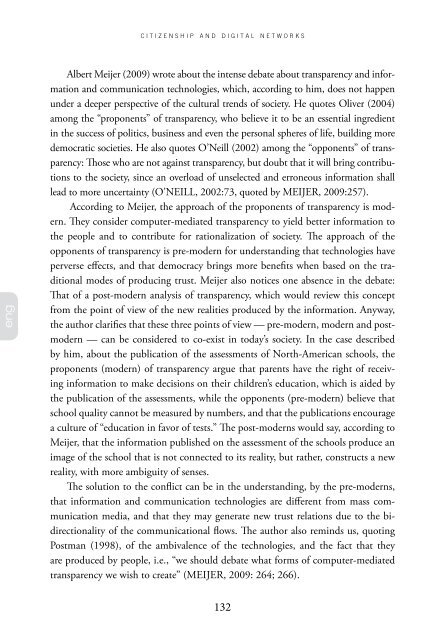Sergio Amadeu da Silveira - Cidadania e Redes Digitais
Sergio Amadeu da Silveira - Cidadania e Redes Digitais
Sergio Amadeu da Silveira - Cidadania e Redes Digitais
Create successful ePaper yourself
Turn your PDF publications into a flip-book with our unique Google optimized e-Paper software.
eng<br />
c i t i z e n s h i p a n d d i g i t a l n e t w o r k s<br />
Albert Meijer (2009) wrote about the intense debate about transparency and information<br />
and communication technologies, which, according to him, does not happen<br />
under a deeper perspective of the cultural trends of society. He quotes Oliver (2004)<br />
among the “proponents” of transparency, who believe it to be an essential ingredient<br />
in the success of politics, business and even the personal spheres of life, building more<br />
democratic societies. He also quotes O’Neill (2002) among the “opponents” of transparency:<br />
Those who are not against transparency, but doubt that it will bring contributions<br />
to the society, since an overload of unselected and erroneous information shall<br />
lead to more uncertainty (O’NEILL, 2002:73, quoted by MEIJER, 2009:257).<br />
According to Meijer, the approach of the proponents of transparency is modern.<br />
They consider computer-mediated transparency to yield better information to<br />
the people and to contribute for rationalization of society. The approach of the<br />
opponents of transparency is pre-modern for understanding that technologies have<br />
perverse effects, and that democracy brings more benefits when based on the traditional<br />
modes of producing trust. Meijer also notices one absence in the debate:<br />
That of a post-modern analysis of transparency, which would review this concept<br />
from the point of view of the new realities produced by the information. Anyway,<br />
the author clarifies that these three points of view — pre-modern, modern and postmodern<br />
— can be considered to co-exist in to<strong>da</strong>y’s society. In the case described<br />
by him, about the publication of the assessments of North-American schools, the<br />
proponents (modern) of transparency argue that parents have the right of receiving<br />
information to make decisions on their children’s education, which is aided by<br />
the publication of the assessments, while the opponents (pre-modern) believe that<br />
school quality cannot be measured by numbers, and that the publications encourage<br />
a culture of “education in favor of tests.” The post-moderns would say, according to<br />
Meijer, that the information published on the assessment of the schools produce an<br />
image of the school that is not connected to its reality, but rather, constructs a new<br />
reality, with more ambiguity of senses.<br />
The solution to the conflict can be in the understanding, by the pre-moderns,<br />
that information and communication technologies are different from mass communication<br />
media, and that they may generate new trust relations due to the bidirectionality<br />
of the communicational flows. The author also reminds us, quoting<br />
Postman (1998), of the ambivalence of the technologies, and the fact that they<br />
are produced by people, i.e., “we should debate what forms of computer-mediated<br />
transparency we wish to create” (MEIJER, 2009: 264; 266).<br />
132


